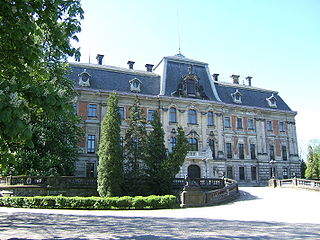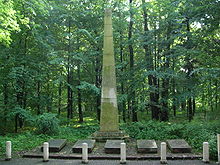- Duchy of Pless
-
The Duchy of Pless (or the Duchy of Pszczyna [1], German: Herzogtum Pleß, Polish: Księstwo Pszczyńskie) was a duchy of Silesia, with its capital at Pless (present-day Pszczyna, Poland).
Contents
History
After the fragmentation of the Polish kingdom upon the 1138 Testament of Bolesław III Krzywousty the lands around the castellany of Pszczyna belonged to the Seniorate Province of Lesser Poland (Małopolska), until in 1177 King Casimir II the Just granted them to the Silesian duke Mieszko I Tanglefoot. Mieszko attached Pszczyna to his Duchy of Racibórz. The Racibórz branch of the Silesian Piasts became extinct with the death of Duke Leszek in 1336.
Before his death, Leszek together with several other Dukes of Silesia had accepted vassalization by King John of Bohemia in 1327, putting his duchy in the Bohemian Crown, acknowledged by King Casimir III the Great of Poland in the 1335 Treaty of Trentschin. In 1336, King John gave the Duchy of Racibórz with Pszczyna to the Přemyslid duke Nicholas II of Opava, who had married late Duke Leszek's sister Anna of Racibórz and ruled both duchies in personal union. In 1407 Nicholas's grandson Duke John II of Opava and Racibórz gave the territory of Pszczyna, Bieruń, Mysłowice and Mikołów as a dowry to his wife Helena, a niece of the Polish king Jogaila. After the acquisition of several villages south of Żory in 1412, Helena upon the death of her husband in 1424 ruled as a Duchess of Pless, succeeded in 1452 by her daughter-in-law Barbara Rockenberg, wife of Helena's son Duke Nicholas V, and the duchy became a part of the Lands of the Bohemian Crown.
From 1462 onwards, Pless was held by the sons of the Bohemian king George of Poděbrady, until Duke Victor of Münsterberg in 1480 sold it to the Silesian duke Casimir II of Cieszyn. In 1517 it was acquired by the Hungarian magnates of the Thurzó family, who again sold it (with the approval of Emperor Ferdinand I, King of Bohemia) in 1548 to the Prince-Bishop of Wrocław, Balthasar von Promnitz. The Promnitz family held the duchy as a state country until 1765.
Principality of Pless
In the War of the Austrian Succession most of Silesia was conquered by the kingdom of Prussia; but the Dukes, and later Princes, of Pless would remain the rulers of the territory. The Dukes of Anhalt-Cöthen-Pless inherited it in 1765 (being descended from the earlier dukes in the female line), the last of them died in 1847, and was succeeded by his nephew, Hans Heinrich X, Count of Hochberg. The Hochbergs, from Fürstenstein near Waldenburg (in Lower Silesia), were father, son and grandson: Hans Heinrich X, XI, and XV;[2] they were among the wealthiest families of Germany, in part because of the mines of Pless.[3]
The Prince's power over his land and its tenants was very great; for example, when the Duke of Ratibor,[4] who had represented the district of Pless-Rybnik in the parliament of the North German Confederation, ran in the first election to the Imperial German Reichstag in 1871, Hans Heinrich XI, Prince of Pless, endorsed him, and was able to enlist even the constabulary, servants of the Prussian state, as election workers; he also threatened the economic well-being of those who opposed his candidate. But the Prince's power was not absolute; the opposition candidate, the "already semi-canonized" Father Eduard Müller, a priest born in Quilitz near Glogau who was active as Catholic missionary in Protestant Berlin, won anyway. This electoral surprise was one of the first great successes of the German Catholic Centre Party which Müller had co-founded; they retained the seat until 1903, when much of the Centre Party's delegation from Upper Silesia was replaced, although by very thin majorities, by the Polish National Democrats.[5]
The Princes of Pless regarded themselves as benevolent lords. Hans Heinrich XI introduced a pension scheme in 1879, before Bismarck's social legislation; also company housing and other social measures. But worker discontent under his son reached the point of a public petition to the Imperial Reichstag.[6]
Alexander II of Russia gave the Hochbergs a herd of wisent in 1864 or 1865, the herd was broken up and reduced to three survivors by poaching at the time of the German Revolution in the aftermath of the First World War.[7]
The Hochbergs were Princes of Pless in the Prussian peerage; however, in 1905, Hans Heinrich XI was created Duke of Pless, for his lifetime only - in part because he had been a Prince for fifty years;[8] in Germany, dukes outranked princes.
Hans Heinrich XV succeeded in 1907; he had married Mary Theresa Cornwallis-West, better known as Daisy, Princess of Pless. He was one of the Kaiser's adjutants during the First World War; several important planning conferences were held at Pless itself during the war; and when the Central powers decided to create a Kingdom of Poland as a German-Austrian protectorate, Hans Heinrich (and, according to his wife, his two elder sons) were among the many to be considered for (and decline) the vacant throne, in part because of their Polish descent.[9]
The Prussian Government attempted to Germanize or assimilate the Poles on its conquered territories, culminating in the Polish Expropriation Act of 1908, which Hans Heinrich XV opposed.[10] The greatest efforts in defence against Germanisation were made by regional newspaper called "Tygodnik Polski Poświęcony Włościanom" ("Polish Weekly for Estate Owners"), which was the first newspaper printed in Polish language in Upper Silesia. [11] the town of Pless was 94.3% Polish in 1829; the whole district remained 86% Polish as late as 1867. [12] About 75% of the voters in the Duchy voted to join Poland in the plebiscite of March 20, 1921 in accordance with the Treaty of Versailles;[13] and the principality was awarded to Poland after the Third Silesian Uprising. The city of Pless (Polish: Pszczyna) however voted to remain within Germany, with a 67% majority. The Duchy therefore ceased to exist when it became part of Second Polish Republic), although the Hochbergs continued to call themselves Princes of Pless.[14]
Notes
- ^ Julian Janczak, "Duchy of Pszczyna" (in) Zarys dziejów kartografii śląskiej do końca XVIII wieku (An outline for the History of Cartography till the End of the 18th century), Opole: 1976, Polish Academy of Sciences, Warsaw: Institute of History of Science, Education and Technology, 1993, ISBN 83-86062-00-2. This contains sections in several European languages, including (English); Accessed 2008-13-01.
^ Tadeusz Walichnowski, Territorial Provenance of Archival Documents in International Relations (Przynaleznosc terytorialna archiwaliow Panstwa Polskiego w stosunkach miedzynarodowych), Polish Scientific Publishers, Warsaw, 1977. Polish State Archives.
^Nagel's Encyclopedia Guide, Poland by Nagel Publishers, 1989, 399 pages, ISBN 2826308181. Accessed 2008-13-01. - ^ The dynastic numbering was, as in other princely families, given to all males of the House.
- ^ Editor's introduction to Daisy, Princess of Pless; for the wealth of the Hochbergs and the mines, see also Anderson,loc. cit..
- ^ Victor Moritz Karl, Prince of Hohenlohe-Waldenburg-Schillingsfürst, also Prince of Corvey; younger brother of Chlodwig, Prince of Hohenlohe-Schillingsfürst, later Chancellor, who had given up the family estates. Half of the district belonged to the Prince of Pless; the Hohenlohes owned much of the rest.
- ^ Anderson, p.1464-68; which contains contemporary accounts of Müller, his charisma, and his charity; "half-saintly" is a quotation from the minutes of the Reichstag, Anderson, p.165. Her analysis is that the landowners of 1871 could indeed suppress any secular opposition; opposition candidates had to hand out ballots to voters, and this could be prevented - but the pulpit was relatively free.
- ^ Koch, pp. 99, 105,109
- ^ Ahrens, p.61.
- ^ Daisy, Princess of Pless, Better Left Unsaid, p.177
- ^ The submarine warfare conferences of August 1916 and January 1917; also the conference of October 1917, which both issued a general invitation to discuss peace terms and invited a Polish delegation to discuss the settlement of Poland. Daisy, Princess of Pless, 420-2; Koch, p. 240; (German) Heinz Lemke, Allianz und Rivaltät, die Mittelmächte und Polen im ersten Weltkrieg (Bis zur Februarrevolution) Vienna (1977), pp. 142, 357; Brunauer, op. cit., pp. 55l, 553f., 568. Princess Daisy wrote that Prince Hans declined for his sons, who were not then of age; the other Hochbergs have not confirmed those offers, but Koch considers them plausible: Alexander, the second son, became a Polish citizen after the war, and was fairly popular in Poland.
- '^ Princess Daisy of Pless. pp. 147-151, and note to p. 151; Koch, p. 154; because of the Parliamentary opposition to it, it remained largely unenforced. - Imanuel Geiss Die Polnische Grenzstreifen, 1914-18, Lübeck, 1960, p.20, which also notes four expulsions in 1911. The policy of moving Poles out was delayed until the war.
- ^ About Polish-Silesian "Tygodnik Polski Poświęcony Włościanom" (Polish Weekly for Estate Owners), University of Bielsko-Biała. Accessed 2008-01-18.
- ^ (Polish) Historia Krajów Słowiańskich; for the district see Anderson, op. cit..
- ^ Koch, p.279
- ^ For example, see Berry; Hans Heinrich XVII, son of Hans Heinrich XV, applied to become a denizen of England in 1933; Berry cites the Times of London referring to him as Prince of Pless, for December 18, 1943. For the more recent history of the house, see Hansel Pless: Prisoner of History : a Life of H.S.H. Hans Heinrich XVII, 4th Prince of Pless by Michael Luke and Patrick Scrivenor. (2002)
References
- Margaret Lavinia Anderson, "Voter, Junker, Landrat, Priest: The Old Authorities and the New Franchise in Imperial Germany" The American Historical Review, Vol. 98, No. 5. (Dec., 1993), pp. 1448-1474. JSTOR link. Pless is chiefly discussed pp. 1464-8.
- Edmund G. Berry, "Cives Sine Suffragio in England"; The Classical Journal, Vol. 39, No. 8. (May, 1944), pp. 490-492, JSTOR link.
- Theodor G. Ahrens, "The Present Status of the European Bison or Wisent" Journal of Mammalogy, Vol. 2, No. 2. (May, 1921), pp. 58-62. JSTOR link.
- Esther Caukin Brunauer, "The Peace Proposals of December, 1916 —January, 1917", The Journal of Modern History, Vol. 4, No. 4. (Dec., 1932), pp. 544-571.
- W. John Koch, Daisy, Princess of Pless, 1873-1943: A Discovery.
- Daisy, Princess of Pless, by Herself. New York (1929) Ed. and Introd. by Maj. Desmond Chapman-Huston.
- Daisy, Princess of Pless: Better Left Unsaid. New York (1931).
External links
- History (an Operetta) by Witold Gombrowicz, in which the last Prince of Pless appears.
Duchies of Silesia 
Original 
Lower Silesia Upper Silesia Duchy of Bielsko · Duchy of Bytom · Duchy of Cieszyn · Duchy of Głubczyce · Duchy of Krnov · Duchy of Opava · Duchy of Opole · Duchy of Opole and Racibórz · Duchy of Oświęcim · Duchy of Pszczyna · Duchy of Racibórz · Duchy of Siewierz · Duchy of ZatorOther Categories:- Duchies of Silesia
- Historical regions in Poland
- Former principalities
- States and territories established in 1517
- Former duchies of the Kingdom of Bohemia
- ^ Julian Janczak, "Duchy of Pszczyna" (in) Zarys dziejów kartografii śląskiej do końca XVIII wieku (An outline for the History of Cartography till the End of the 18th century), Opole: 1976, Polish Academy of Sciences, Warsaw: Institute of History of Science, Education and Technology, 1993, ISBN 83-86062-00-2. This contains sections in several European languages, including (English); Accessed 2008-13-01.
Wikimedia Foundation. 2010.



